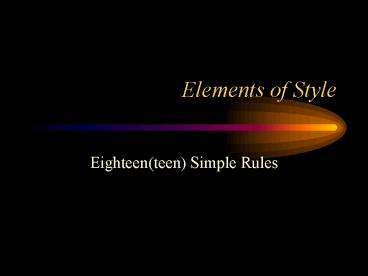Elements of Style PowerPoint PPT Presentation
1 / 18
Title: Elements of Style
1
Elements of Style
- Eighteen(teen) Simple Rules
2
Elementary Rules of Usage
- Form the possessive of singular nouns with s.
- In a series of three or more terms with a single
conjunction, use a comma after each term except
the last. - Enclose parenthetical expressions between commas.
- Place a comma before and or but introducing an
independent clause.
3
Elementary Rules of Usage
- Do not join independent clauses by a comma
- Do not break sentences in two
- A participial phrase at the beginning of a
sentence must refer to the grammatical subject - Divide words at line-ends, in accordance with
their formation and pronunciation
4
Elementary Principles of Composition
- Make the paragraph the unit of composition one
paragraph to each topic - As a rule, begin each paragraph with a topic
sentence end it in conformity with the beginning
- Use the active voice
- Put statements in positive form
5
Elementary Principles of Composition
- Omit needless words
- Avoid a succession of loose sentences
- Express co-ordinate ideas in similar form
- Keep related words together
6
ELEMENTARY PRINCIPLES OF COMPOSITION
- In summaries, keep to one tense
- Place the emphatic words of a sentence at the end
7
Form the possessive singular of nouns with 's.
- Follow this rule whatever the final consonant.
Thus write, - This is the usage of the United States Government
Printing Office and of the Oxford University
Press.
8
Form the possessive singular of nouns with 's.
- Exceptions are the possessives of ancient proper
names in -es and -is, the possessive Jesus', and
such forms as for conscience' sake, for
righteousness' sake. But such forms as Achilles'
heel, Moses' laws, Isis' temple are commonly
replaced by
9
Form the possessive singular of nouns with 's.
- The pronominal possessives
- hers,
- its,
- theirs,
- yours, and
- oneself
- have no apostrophe.
10
In a series of three or more terms with a single
conjunction, use a comma after each term except
the last.
- Thus write,
- This is also the usage of the Government Printing
Office and of the Oxford University Press.
11
In a series of three or more terms with a single
conjunction, use a comma after each term except
the last.
- In the names of business firms the last comma is
omitted, as - The abbreviation etc., even if only a single term
comes before it, is always preceded by a comma.
12
Enclose parenthetic expressions between commas.
- The best way to see a country, unless you are
pressed for time, is to travel on foot. - Such punctuation as
- Marjorie's husband, Colonel Nelson paid us a
visit yesterday, - or
- My brother you will be pleased to hear, is now
in perfect health, - is indefensible.
13
Enclose parenthetic expressions between commas.
- Non-restrictive relative clauses are, in
accordance with this rule, set off by commas.
The audience, which had at first been
indifferent, became more and more interested.
14
Enclose parenthetic expressions between commas.
- Similar clauses introduced by where and when are
similarly punctuated. - In 1769, when Napoleon was born, Corsica had but
recently been acquired by France. - Nether Stowey, where Coleridge wrote The Rime of
the Ancient Mariner, is a few miles from
Bridgewater.
15
Enclose parenthetic expressions between commas.
- In these sentences the clauses introduced by
which, when, and where are non-restrictive they
do not limit the application of the words on
which they depend, but add, parenthetically,
statements supplementing those in the principal
clauses. - Each sentence is a combination of two statments
which might have been made independently. - The audience was at first indifferent. Later it
became more and more interested. - Napoleon was born in 1769. At that time Corsica
had but recently been acquired by France. - Coleridge wrote The Rime of the Ancient Mariner
at Nether Stowey. Nether Stowey is only a few
miles from Bridgewater.
16
Restrictive relative clauses are not set off by
commas.
- The candidate who best meets these requirements
will obtain the place. - In this sentence the relative clause restricts
the application of the word candidate to a single
person. Unlike those above, the sentence cannot
be split into two independent statements.
17
Enclose parenthetic expressions between commas.
- The abbreviations etc. and jr. are always
preceded by a comma, and except at the end of a
sentence, followed by one. - If a parenthetic expression is preceded by a
conjunction, place the first comma before the
conjunction, not after it. - He saw us coming, and unaware that we had learned
of his treachery, greeted us with a smile.
18
Place a comma before and or but introducing an
independent clause.
- The early records of the city have disappeared,
and the story of its first years can no longer be
reconstructed. - The situation is perilous, but there is still
one chance of escape. In the example above,
the relation is that of cause and result. The two
sentences might be rewritten As the early
records of the city have disappeared, the story
of its first years can no longer be
reconstructed. - Although the situation is perilous, there is
still one chance of escape.

